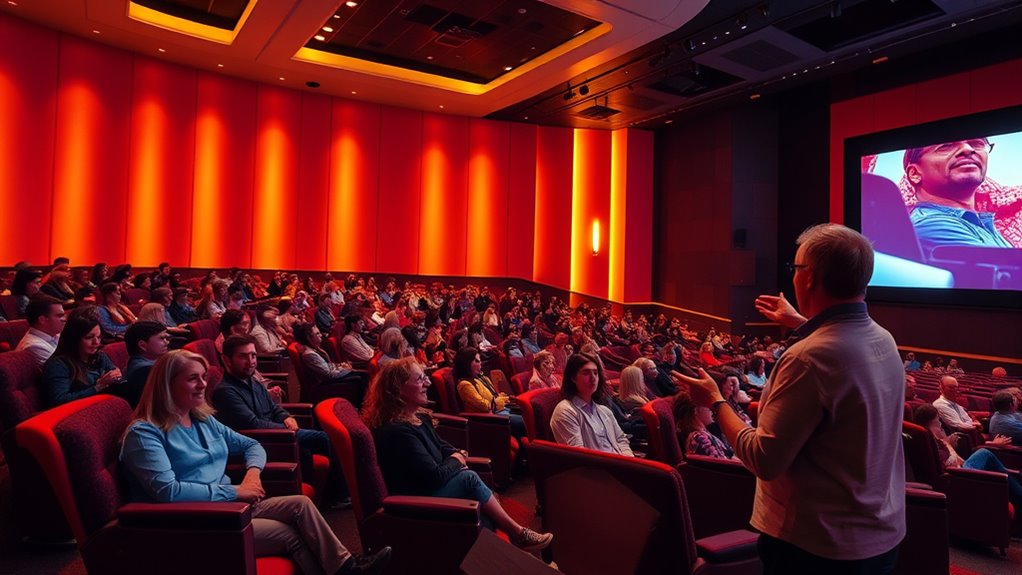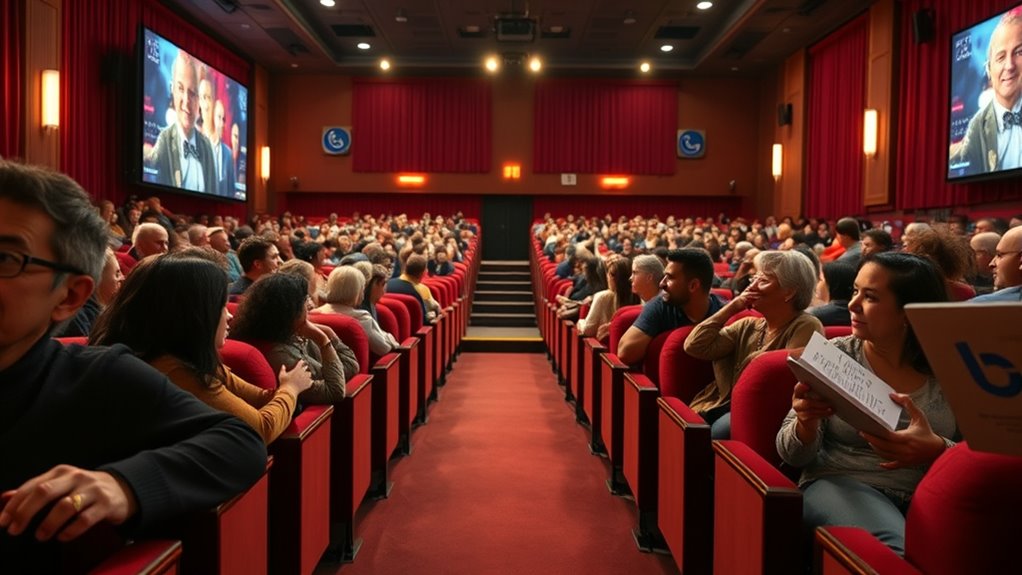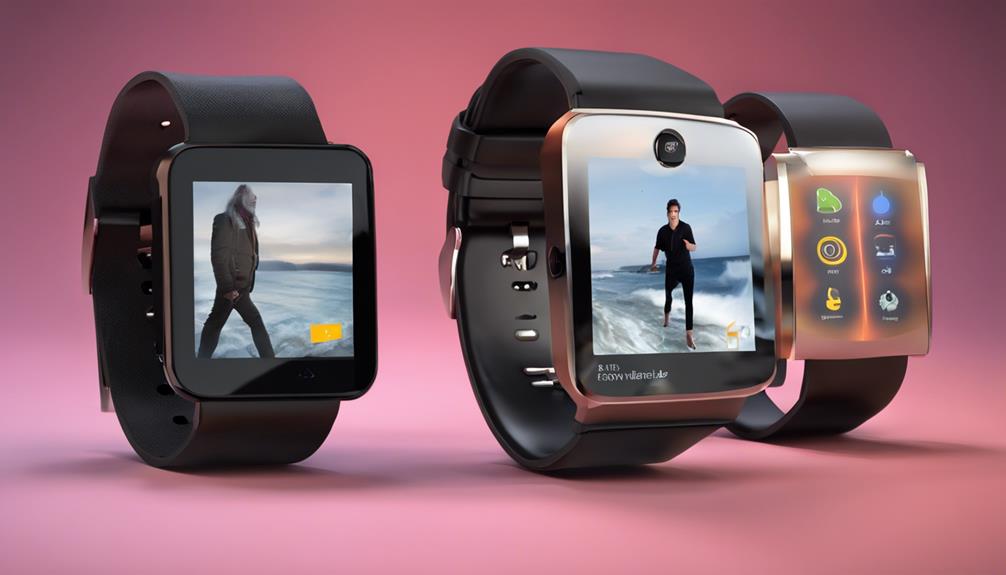To get the most out of accessible movies and theater, use available features like audio descriptions, captions, and assistive listening devices. Check venue websites beforehand to find information about accommodations, seating, and resources. Arrive early to familiarize yourself with the environment and ask staff for assistance if needed. Modern theaters also offer ramps and designated spaces for ease of access. Exploring these options guarantees a comfortable, engaging experience—keep exploring to discover more ways to maximize your enjoyment.
Key Takeaways
- Use audio descriptions and assistive listening devices to enhance understanding and enjoyment of movies and performances.
- Check venue accessibility features online beforehand, including ramps, seating, and audio description services.
- Utilize technology like synchronized audio description devices and captioning to make experiences more inclusive.
- Seek out venues that prioritize physical accessibility and staff trained to assist visitors with impairments.
- Provide feedback to venues to promote ongoing improvements and expand accessible entertainment options.

Accessible movies and theater are transforming entertainment to include everyone, regardless of physical or sensory impairments. This shift guarantees that everyone can enjoy the magic of movies and live performances without barriers. If you have a visual impairment, audio descriptions are a game-changer. These provide a spoken narration of visual elements, helping you understand what’s happening on screen or stage. When theaters incorporate audio descriptions, you can follow the story more clearly, immersing yourself in the experience just like everyone else. Many venues now offer devices that sync with the film or performance, making it easier to access descriptions without disrupting other viewers. This technology is crucial for creating an inclusive environment where you’re not left out of the storytelling.
Wheelchair accessibility is equally important in making entertainment venues welcoming. Modern theaters and cinemas are increasingly designed with ramps, elevators, and designated seating to accommodate wheelchair users comfortably. When you arrive, you’ll notice designated accessible seats that provide clear sightlines and easy entry. These features guarantee that you can enjoy the performance fully, without worrying about navigating complicated layouts. The goal is to make sure you feel comfortable and independent while attending. Staff training also plays a role; employees are often prepared to assist with seating and accommodations, making the process seamless. Accessibility isn’t just about physical features — it’s about creating an environment where you feel valued and included.
Many theaters now offer online resources to help you plan your visit. You can check whether a venue has audio description services or wheelchair-accessible seating in advance, so you’re prepared. Some cinemas and theaters also provide assistive listening devices or captioning services for those with hearing impairments, further expanding entertainment options. By taking advantage of these accommodations, you guarantee that your experience is as enjoyable and hassle-free as possible. Additionally, sound vibrations are being explored as a way to enhance immersive experiences for those with sensory impairments, opening new avenues for inclusive entertainment. It’s also worth advocating for more inclusive practices; your feedback can encourage venues to improve and expand their accessibility options.
Ultimately, accessible movies and theater are about removing obstacles so you can focus on the story and the performance. Whether it’s through audio descriptions that bring visuals to life or wheelchair-accessible spaces that ensure comfort and independence, the focus is on inclusion. By embracing these advancements, you’ll find it easier to participate in entertainment activities and share memorable moments with friends and family. The more accessible venues become, the more everyone can enjoy the magic of movies and live theater, creating a richer, more diverse entertainment landscape for all.
Frequently Asked Questions
What Are the Latest Technological Advancements in Accessible Theater Experiences?
You’ll find that the latest advancements include enhanced audio description technology, offering clearer, more detailed narration for visually impaired audiences. Sign language interpretation is now more seamlessly integrated with live and pre-recorded performances through innovative virtual and augmented reality tools. These technologies make theater more inclusive by providing real-time accessibility, ensuring everyone can enjoy the experience fully. Embrace these innovations to get the most out of accessible theater experiences today.
How Can Theaters Improve Accessibility for Hearing-Impaired Audiences?
You can improve accessibility for hearing-impaired audiences by offering sign language interpretation and audio description services, which 85% of theaters now adopt. These features allow everyone to enjoy performances fully. Consider installing FM systems or loop technology for clearer sound, and train staff to assist with these services. By prioritizing these options, you create an inclusive environment where all guests can experience the magic of theater.
Are There Specific Apps or Devices That Enhance Movie Accessibility?
Yes, there are apps and devices that enhance movie accessibility. You can use apps with audio descriptions that narrate visual elements, making movies more understandable. Devices with haptic feedback provide tactile cues for sound cues or important moments, helping you stay engaged. Many theaters also offer these technologies, so check with your venue beforehand. These tools make watching movies more inclusive, ensuring you don’t miss out on any key details.
What Policies Support Inclusive Access in Mainstream Cinemas?
Imagine stepping into a theater where everyone’s voice is heard, like a garden where all flowers bloom. Policies like senior discounts and sensory-friendly screenings support inclusive access, ensuring no one feels left out. These policies act as gentle bridges, welcoming diverse audiences and fostering understanding. By embracing such initiatives, mainstream cinemas create a space where everyone can enjoy movies together, celebrating shared stories and experiences without barriers.
How Do Color Contrast and Lighting Affect Visually Impaired Viewers?
Color contrast and lighting design profoundly impact your viewing experience if you’re visually impaired. High color contrast helps you distinguish objects and text clearly, reducing confusion and eye strain. Proper lighting minimizes glare and shadows, making scenes easier to see. When theaters optimize these elements, they ensure you can enjoy movies comfortably and fully. Good lighting and contrast create an inclusive environment, making visual storytelling accessible and enjoyable for everyone.
Conclusion
So, after all this talk about accessibility, it’s ironic that the very world meant to entertain often forgets those who need it most. With advancements in technology and awareness, you’d think barriers would be a thing of the past. Yet, here we are, still working toward a theater experience that truly includes everyone. Luckily, your voice and choices can help turn the tide—because nothing says progress like enjoying a movie without limits.









